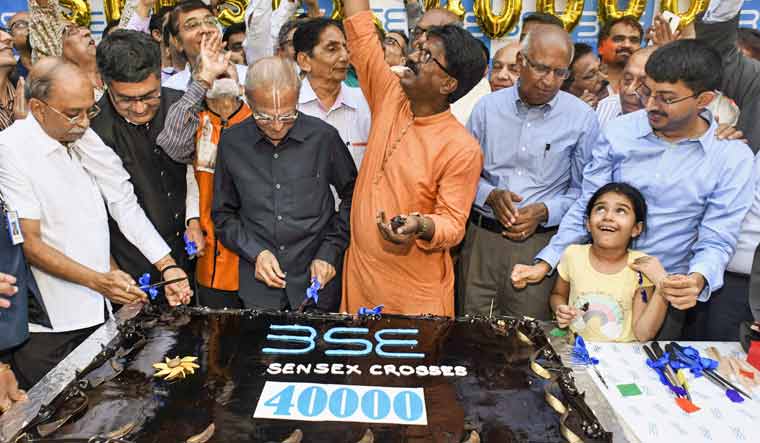It was a roller coaster ride for equity investors on Thursday. The BSE Sensex crossed 40,000 level for the first time, after trends showed the Narendra Modi-led NDA returning back to power. However, profit booking in the afternoon saw the benchmark index fall almost 1,500 points from the life high, before closing at 38,811.39, down 299 points or 0.8 per cent. The Sensex hit a high of 40,124.96 and a low of 38,651.61 during the trading session.
It was similar trend on the NSE, where the Nifty 50 index hit a high of 12,041.15 and a low of 11,614.50, before ending the day at 11,657.05, down 81 points or 0.7 per cent.
Over the last six sessions the Sensex had surged more than 5 per cent on the expectation that the NDA will win a majority in the Lok Sabha elections and with the trends largely on the expected line, investors chose to book profits.
“Markets were initially enthused to see the election results falling in line with the exit polls. However, the run up to the d–day was so sharp that, it turned out to be a sell on news phenomenon,” said Devang Mehta, head of equity advisory at Centrum Wealth Management.
The biggest gainers on Thursday included IndusInd Bank, which surged over 5 per cent. Among other gainers, Coal India, Yes Bank, Hero MotoCorp, Power Grid, ICICI Bank and Larsen & Toubro were all up more than 1 per cent. Vedanta was the top loser on the Sensex, falling 5.5 per cent, ITC was down 3.7 per cent and Bajaj Finance, Tata Motors and HDFC Bank were also down more than 2 per cent.
“Investors now have political stability and predictability of economic policies, which they normally look forward to before investing with a long-term time horizon. India’s economy has typically accelerated after formation of new governments with some energised policy making, greater predictability and higher corporate risk appetite. This augurs well for the country as there is going to be a continuity in policies,” said Dhiraj Relli, MD and CEO of HDFC Securities.
The election uncertainties will soon be out of the way, but there are several challenges on the economic front, which domestic as well foreign investors will want to see addressed by the new government.
While inflation may be low, India’s factory output contracted in March. From 8 per cent in the April-June 2018 quarter, the GDP growth slowed to 6.6 per cent in the third quarter and is likely to have further slowed down in the January-March quarter. Automobile sales have declined, consumer goods volume growth too has slowed.
“Reeling under consumption slowdown amid liquidity crisis in NBFC sector and lower terms of trade in the agriculture sector, optimism around India’s economic growth has come to a grinding halt. With limited fiscal space amid compelling priorities and electoral promises, the Modi government’s second term in office is likely to be more challenging than the first,” said Garima Kapoor, economist at Elara Capital.
Measures to revive consumption, addressing financial sector "dislocation" by recapitalising state-owned banks, fuelling manufacturing sector to ensure job creation, solving the conundrum of skill shortage in the country to ensure employability, enhancing micro-irrigation facilities, increasing credit to agriculture and boosting farm prices should be among the immediate priorities of the government, added Kapoor.
From a market perspective, the election result would remove the uncertainty of the event and is a clear status quo scenario, given the continued BJP majority, said Prabhat Awasthi, head of India at Nomura Securities.
“Longer term, the big question is whether NDA 2.0 would be materially different from NDA 1.0. The upside scenario for the economy and the market is that as the benefits of some of the structural reforms such as GST, Bankruptcy bill, etc., start flowing in, the government moves and focuses on the next round of policy reforms,” added Awasthi.
Rusmik Oza, head of fundamental research at Kotak Securities said some of the passive money that had come in the last three months at lower levels could be going out due to global worries. The trade tensions between the US and China have escalated in recent weeks and the US has also upped its pressure on Iran.
Oza further said that expensive valuations of Nifty closer to 12,000 levels (19 times forward price to equity) provided limited upside in large caps.
“There could be some near term concerns emanating from earnings downgrades,” he added.
According to Relli of HDFC Securities, the results raise hopes of the issues being faced by the economy being tackled in a firm and prudent way. However, uncertainty on various fronts remain.
“Global issues may bother a bit less in the near term though their shadows can linger on. Earnings growth challenge will continue in the near term till monsoon spread and intensity is assured and liquidity situation eases,” he opined.



